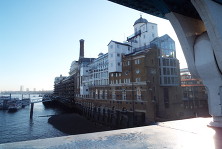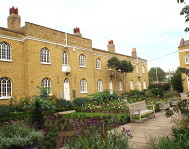








The Paragon, with the exception of No. 15 that was later a rectory for St George the Martyr, was demolished in 1898 to make way for a school*. Ownership of the land had passed to John Rolls, 1st Baron Llangattock, who a couple of years later was to donate land in Camberwell for the building of a library, baths and wash-house. Lord Llangattock was intending to build on the area that had been the communal garden, but as a member of the Metropolitan Public Gardens Association, he was amenable to the suggestion from the Association that the land be used for a public garden. He offered to sell the land for the price of £3,400, which was considered reasonable, and donated £1000 himself. The balance was forthcoming from the Vestry of St George the Martyr and the London County Council, the Vestry agreeing to maintain the new garden if the MPGA laid it out.
The new garden kept its semi circular shape, and was much smaller than it is today. It was opened on 28 June 1899, a “beautifully fine” day, by Lady Llangatock whose husband presented 12 additional seats for the Garden. Mr Basil Holmes, Secretary to the MPGA, writing in The Times about the formation of the new public garden, described the appearance as charming and paid credit to the lady landscaper Miss F Wilkinson who planned and carried out the work.
A strip of land closest to the road was lost as a result of road widening and the building of the Bricklayers Arms flyover in the 1970s. An old map shows a line of trees planted in the park on the boundary with the road which must have been destroyed. At the same time, houses to the east of the garden and more so to the west were cleared. The garden, losing its distinct semi-circular shape, was extended to include this extra land and now extends as far as Driscoll House, and remains an attrative open patch of green with a winding path and established trees and shrubs.
*The school was called The Paragon School and closed in 1980. The building has now been converted into luxury flats.
Paragon Gardens
Paragon Garden is a long narrow garden on the south side of New Kent Road. It was named after The Paragon, a row of 15 large houses built in the form of a crescent and separated from the New Kent Road by a similarly crescent shaped communal garden. Built at the end of the eighteenth century on land belonging to the Rolls family who owned a large amount of land in the area, they were constructed to an elegant design and a high specification to attract the middle classes. Searles Road cuts through the gardens, named after the architect for the Paragon.
A brass band that went by the name “Perseverance” was given permission to play in the Garden one evening a week during August of that year. The concerts were popular and attended in large numbers. The LCC were approached by the Vestry of St George the Martyr to arrange for bands to give similar weekly performances during the following year which the Council agreed to on condition suitable arrangements were made for the accommodation of the band. The Vestry immediately set about obtaining tenders and later the construction of a bandstand. Sadly the bandstand has not survived.
Web discoveries
- UK Casino Not On Gamstop
- UK Casino Not On Gamstop
- Non Gamstop Casino
- Casinos Not On Gamstop
- Non Gamstop Casinos
- Non Gamstop Casinos
- Non Gamstop Casino
- Casino Sites Not On Gamstop
- Slots Not On Gamstop
- Casinos Not On Gamstop
- UK Betting Sites Not On Gamstop
- UK Casino Not On Gamstop
- Best Non Gamstop Casinos
- Betting Sites
- Non Gamstop Casino Sites UK
- Best Non Gamstop Casinos
- Non Gamstop Casino
- Casinos Not On Gamstop
- Non Gamstop Casino Sites UK